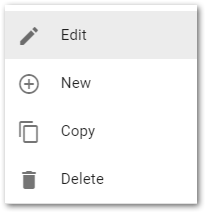•Downloading Individual or Multiple Dashboards
•Transferring a Dashboard across Databases
•Widgets and Dashboard Sections
Dashboards may be downloaded and transferred to a different database as follows.
Downloading Individual or Multiple Dashboards
Users can use the Explorer widget to download individual or multiple dashboards.
Uploading a Dashboard
A dashboard file (in the *.dashboard filetype) can be re-deployed to the same database or another database using one of the following methods. Note that the Module Manager Widget can only be accessed by users assigned to the Administrator role.
Dashboards uploaded to another database may have reference issues; for more information, see the next section.
For facility-specific dashboards, use Method 1, appending the site URL (see Warning box below).
Method 1: Appending the Site URL
1.Save the dashboard download in the Enterprise deploy folder, typically at C:\Program Files\EarthSoft\EQuIS\Enterprise7\deploy.
2.Load the deploy site (e.g., https://enterprise.somewhereonline.com/default.aspx?action=deploy) and login to deploy the new dashboard(s).
Warnings: •When deploying dashboards to a new site, if the incoming dashboard file shares the same URL as an existing one, it will automatically overwrite the currently deployed dashboard. •For facility-specific dashboards, if the URL does not include a unique name value, existing facility-specific dashboards will be overwritten. If deploying a facility-specific dashboard to a database, modify the URL field within the ".dashboard" file by appending a unique name value, as shown in the bolded and highlighted text below: url": "f=12345&name=[unique_name]", |
Method 2: Using the Module Manager Widget (administrators only)
1.Navigate to a dashboard that currently contains the Module Manager widget or add the Module Manager widget to a dashboard.
2.Drag the ".dashboard" file into the Drag and Drop section of the Module Manager widget. Select Upload.
3.If the ".dashboard" file uploaded successfully, the file will appear at the top of the Module Manager grid.
4.Navigate to the Dashboard Chooser and select the newly deployed dashboard.
|
When importing the ".dashboard" file through the Module Manager widget (POST api/modules or GET api/modules/deploy), the widget attempts to map the owner specified in the ".dashboard" file to an existing user via the following rules:
•If 0 = the dashboard's userId field, then assign the current user as the owner of the dashboard.
•Else, if 0 > the dashboard's userId field or the owner field is null or empty, assign the .system user as the owner of the dashboard.
•Else, attempt look up a user by the userId field and verify that the owner field matches either their USER_NAME or EMAIL_ADDRESS. If so, then they retain ownership of the dashboard.
•Else, attempt to find an active user with either USER_NAME or EMAIL_ADDRESS matching the dashboard's owner field. If found, that user is assigned ownership of the dashboard.
•Finally, if none of the earlier attempts succeed, then the .system user is assigned owner of the dashboard.
Transferring a Dashboard across Databases
Widgets and Dashboard Sections
IDs associated with a widget, dashboard, or section do not need editing prior to deployment; these will be adjusted to follow the target database's EQuIS Unique Identifier (EUID) numbering.
The userSettings section for a widget will contain the database-specific IDs for a specific object. A negative sign may appear in front of the ID; leave this sign in place. Here are some examples highlighting the position of the IDs to update when transferring a dashboard to a new database:
•EZView Widget with a base report
"userSettings": "{\"ReportId\":18496,\"AllowAdHocRun\":true,\"reportName\":\"Action Level Exceedance II with Parameters\",\"dataSource\":{\"url\":\"api/reports/18496/data\",\"type\":\"class\",\"name\":\"Action Level Exceedance II with Parameters\",\"id\":18496,\"outputFormat\":null,\"eiaStatistics\":null}}",
•RDL Report Viewer Widget with a user report
"userSettings": "{\"showToolbar\":true,\"userReportId\":-31929,\"windowHeight\":500}",
•PDF Viewer with a file
"userSettings": "{\"selectedPdf\":[{\"file_type\":\".pdf\",\"facility_id\":null,\"place_type\":null,\"place_code\":null,\"place_subcode\":null,\"file_date\":\"2023-07-26\",\"confidential_yn\":\"N\",\"external_url\":null,\"title\":\"My PDF\",\"author\":null,\"file_parameters\":[],\"object_euid\":null,\"content\":null,\"path\":null,\"id\":146278,\"code\":null,\"type\":\"A\",\"objectType\":16,\"remark\":null,\"owner\":\"MyUser\",\"permission\":1,\"name\":\"My-PDF.pdf\",\"isFavorite\":null,\"isRecent\":null,\"tag\":\"230\",\"actions\":null,\"memberOf\":null}]}",
Downloading a dashboard does not remove it from the database (i.e., it is copied rather than cut).
Report Reference Updates
When downloading a dashboard in one database and deploying it to another, tags can be used to make references to user reports and reports update automatically. Use the following tag format, enclosed within two pairs of curly brackets, in the dashboard file:
{{[report_type]:[report_name]}}
In the tag, "report_type" can be either "report" or "user_report". For example:
•{{report:Geotechnical Analytical Results}}
•{{user_report:Boring IDs}}
or
{{user_report:EnviroInsite Boring Logs II [Field and Lab]}}
The name must match exactly; do not omit special characters in the report/user report name.
Create a self-updating report/user report reference as follows:
1.Publish the relevant reports (and their dependencies) and save the relevant user reports in the target database if they do not already exist.
2.Locate the REPORT_ID or USER_REPORT_ID value for the report or user report in the *.dashboard file, as shown in the Widgets and Dashboard section.
3.Find and Replace that value in the document with the appropriate tag, constructed as follows:
a.Two opening curly brackets, {{
b.The report type, report or user_report
c.A colon, :
d.The exact report/user report name from Step 1
e.Two closing curly brackets, }}
4.Save the dashboard file.
5.Upload and deploy the dashboard to the new database, per the Uploading a Dashboard section above.
Additional information:
•When encountered, the tag is replaced with the User Report ID or Report ID found in the database.
•User reports will be identified by the name in ST_USER_REPORT.NAME. If a duplicate name exists for a user report, the latest USER_REPORT_ID will be used.
•Reports will be identified by the name in ST_REPORT.DISPLAY_NAME.
•If a report is not found, the tag will be replaced by NULL and the report name in the tag will be replaced by an empty string (i.e., ""). For the report name to be replaced, the name needs to exactly match the report name in the tag.
Warning: If a string similar to a tag is added to the dashboard file, it will be replaced with NULL. For example, if the user names a property in the user settings "{{report:Report Name}}", that string will be replaced with NULL. |
